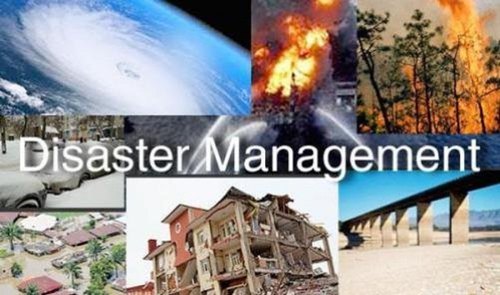
Disclaimer: Copyright infringement not intended.
Context
- Rashtrapati Bhavan, in association with the National Institute of Disaster Management (NIDM), has organised a workshop on “Disaster Management of Museums and Heritage Buildings”, at the Rashtrapati Bhavan Museum.
Details
- The aim of this workshop is to create awareness among the officials of Rashtrapati Bhavan and other stakeholders towards disaster management with special focus on heritage buildings, museums and cultural heritage.
- During the two-day workshop, participants will learn about the various aspects of Disaster Management Act; Disaster Management framework and guidelines; Sendai Framework for Disaster Risk Reduction (SFDRR); Prime Minister’s 10 Point Agenda on Disaster Risk Reduction etc in different sessions.
Disaster management
- Disaster management refers to the conservation of lives and property during natural or human-made disasters. Disaster management plans, by protecting from disease and droughts. Disaster management can be of either natural disasters or man-made disasters.
Some International Summits and bodies
World Conferences on Disaster Risk Reduction
The World Conference on Disaster Risk Reduction is a series of United Nations conferences focusing on disaster and climate risk management in the context of sustainable development. The World Conference has been convened three times, with each edition to date having been hosted by Japan: in Yokohama in 1994, in Kobe in 2005 and in Sendai in 2015.
1994 First World Conference on Natural Disasters in Yokohama
The First World Conference on Natural Disasters in Yokohama, Japan from 23 to 27 May 1994, adopted the Yokohama Strategy for a Safer World: Guidelines for Natural Disaster Prevention, Preparedness and Mitigation and its Plan of Action, endorsed by the UN General Assembly in 1994. It was the main outcome of the mid-term review of the International Decade of Natural Disaster Reduction (IDNDR) and established 10 principles for its strategy, a plan of action and a follow-up. Furthermore, it provides guidelines for natural disaster prevention, preparedness and mitigation.
Ten principles of the Yokohama Strategy for a Safer World
The ten principles of the Yokohama Strategy for a Safer World:
- Risk assessment is a required step for the adoption of adequate and successful disaster reduction policies and measures.
- Disaster prevention and preparedness are of primary importance in reducing the need for disaster relief.
- Disaster prevention and preparedness should be considered integral aspects of development policy and planning at national, regional, bilateral, multilateral and international levels.
- The development and strengthening of capacities to prevent, reduce and mitigate disasters is a top priority area to be addressed during the Decade so as to provide a strong basis for follow-up activities to the Decade.
- Early warnings of impending disasters and their effective dissemination using telecommunications, including broadcast services, are key factors to successful disaster prevention and preparedness.
- Preventive measures are most effective when they involve participation at all levels, from the local community through the national government to the regional and international level.
- Vulnerability can be reduced by the application of proper design and patterns of development focused on target groups, by appropriate education and training of the whole community.
- The international community accepts the need to share the necessary technology to prevent, reduce and mitigate disaster; this should be made freely available and in a timely manner as an integral part of technical cooperation.
- Environmental protection as a component of sustainable development consistent with poverty alleviation is imperative in the prevention and mitigation of natural disasters.
- Each country bears the primary responsibility for protecting its people, infrastructure, and other national assets from the impact of natural disasters. The international community should demonstrate strong political determination required to mobilize adequate and make efficient use of existing resources, including financial, scientific and technological means, in the field of natural disaster reduction, bearing in mind the needs of the developing countries, particularly the least developed countries.
Hyogo Framework for Action
The Hyogo Framework for Action (2005–2015): Building the Resilience of Nations and Communities to Disasters was an outcome of the 2005 conference. The Hyogo Framework (HFA) was the first plan to explain, describe and detail the work required from all different sectors and actors to reduce disaster losses. It was developed and agreed on with the many partners needed to reduce disaster risk – governments, international agencies, disaster experts and many others – bringing them into a common system of coordination. The HFA, which ran from 2005 to 2015, set five specific priorities for action:
- Making disaster risk reduction a priority;
- Improving risk information and early warning;
- Building a culture of safety and resilience;
- Reducing the risks in key sectors;
- Strengthening preparedness for response.
2015 Third UN World Conference on Disaster Risk Reduction (WCDRR) in Sendai
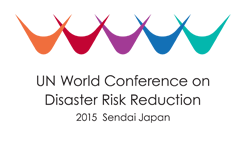
The conference adopted the Sendai Framework for Disaster Risk Reduction 2015–2030. The Sendai Framework is the first major agreement of the post-2015 development agenda, with seven targets and four priorities for action. It was endorsed by the UN General Assembly in June 2015.
Sendai Framework for Disaster Risk Reduction 2015–2030
The Sendai Framework is a 15-year non-binding agreement which recognizes that the State has the primary role to reduce disaster risk but that responsibility should be shared with other stakeholders including local government and the private sector. It aims for the following outcome:
’’The substantial reduction of disaster risk and losses in lives, livelihoods and health and in the economic, physical, social, cultural and environmental assets of persons, businesses, communities and countries.’’
The Sendai Framework emerged from three years' of consultations and negotiations, supported and coordinated by UNISDR, during which UN member states, NGOs and other stakeholders made calls for an improved version of the existing Hyogo Framework, with a set of common standards, a comprehensive framework with achievable targets, and a legally-based instrument for disaster risk reduction. Based on the Sendai Framework, the first was held in New Delhi as part of Asian ministerial conference for disaster risk reduction.Member states also emphasised the need to tackle disaster risk reduction and climate change adaption when setting the Sustainable Development Goals, particularly in light of an insufficient focus on risk reduction and resilience in the original Millennium Development Goals.
The Sendai Framework sets four specific priorities for action:
- Understanding disaster risk;
- Strengthening disaster risk governance to manage disaster risk;
- Investing in disaster risk reduction for resilience;
- Enhancing disaster preparedness for effective response, and to "Build Back Better" in recovery, rehabilitation and reconstruction.
To support the assessment of global progress in achieving the outcome and goal of the Sendai Framework, seven global targets have been agreed:
- Substantially reduce global disaster mortality by 2030, aiming to lower average per 100,000 global mortality between 2020–2030 compared to 2005–2015;
- Substantially reduce the number of affected people globally by 2030, aiming to lower the average global figure per 100,000 between 2020–2030 compared to 2005–2015;
- Reduce direct disaster economic loss in relation to global gross domestic product by 2030;
- Substantially reduce disaster damage to critical infrastructure and disruption of basic services, among them health and educational facilities, including through developing their resilience by 2030;
- Substantially increase the number of countries with national and local disaster risk reduction strategies by 2020;
- Substantially enhance international cooperation to developing countries through adequate and sustainable support to complement their national actions for implementation of the framework by 2030;
- Substantially increase the availability of and access to multi-hazard early warning systems and disaster risk information and assessments to the people by 2030.
United Nations International Strategy for Disaster Reduction (UNISDR)-
In order to build the resilience of nations and communities to disasters through the implementation of the HFA , the UNISDR strives to catalyze, facilitate and mobilise the commitment and resources of national, regional and international stakeholders of the ISDR system.
United Nation Disaster Management Team (UNDMT)
- To ensure a prompt, effective and concerted country-level support to a governmental
response in the event of a disaster, at the central, state and sub-state levels,
- To coordinate UN assistance to the government with respect to long term recovery, disaster mitigation and preparedness.
- To coordinate all disaster-related activities, technical advice and material assistance provided by UN agencies, as well as to take steps for optimal utilisation of resources by UN agencies.
Disaster Management in India
- India has been traditionally vulnerable to natural disasters on account of its unique geo-climatic conditions. Floods, droughts, cyclones, earthquakes and landslides have been recurrent phenomena. About 60% of the landmass is prone to earthquakes of various intensities; over 40 million hectares is prone to floods; about 8% of the total area is prone to cyclones and 68% of the area is susceptible to drought. In the decade 1990-2000, an average of about 4344 people lost their lives and about 30 million people were affected by disasters every year. The loss in terms of private, community and public assets has been astronomical.
- Thus, in addition to the traditional responsibilities, India will have to provide relief & immediate rehabilitation—steps should be taken to prevents or mitigate its effects
- AIM - building resilience of the communities to face crisis and ensuring their full participation
Govt + Local Bodies + Civil Society + Voluntary organizations + Corporate Bodies together strive for disaster mitigation
3 phases of Disaster Management
- Pre Crisis :- Preparedness
- During Crisis :- Emergency response
- Post Crisis :- Recovery, Rehabilitation & Reconstruction
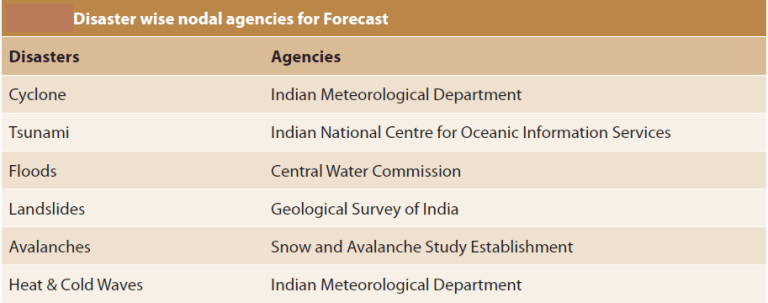
Community is usually the first responder in case of a disaster in urban areas the response is articulated by agencies like the civic authorities, the fire brigade and the local police station. At present, panchayats do not have the capacity to react in case of disaster.
So, it is the district administration, which retains the basic responsibility of handling crises situations with the Collector playing a pivotal role.
Constitution of India: Disaster Management
- Indian Constitution has specified specific roles for the Union and State Governments.
- However, the subject of disaster management does not find mention in any of the three lists in the Seventh Schedule of the Indian Constitution.
State Government & Disaster Management
- State Governments = post disaster relief and rehabilitation
- A few states have created a separate Disaster Management Department.
Role of CM
- A Cabinet Committee on Natural Calamitiesunder the chairpersonship of the Chief Minister takes stock of situations and is responsible for all important policy decisions.
Role of Chief Secretary
- Every state has a Crisis Management Committeeunder the chairpersonship of the Chief Secretary,
- It reviews crisis situations on a day-to-day basis at the time of crisis,
- coordinates the activities of all departments and provides decision support system to the district administration
Role of District Collector
- District Magistrate/Collector has the responsibility for the overall management of disasters in the district.
- All departments of the State Government including the police, fire services, public works, irrigation etc. work in a coordinated manner under the leadership of the Collector during a disaster, except in metropolitan areas where the municipal body plays a major role.
- District Collector also enjoys the authority to request for assistance from the Armed Forces if circumstances so demand
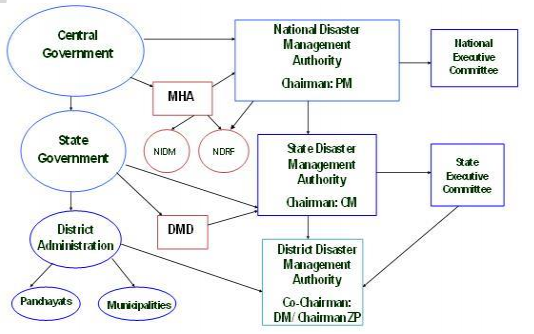
Union Government & Disaster Management
- Union Government plays a key supportive role by
- Giving physical and financial resources
- early warning and co-ordination of efforts of all Union ministries, departments and organizations
- Till recently, the Department of Agriculture had the nodal responsibility for managing disasters.
- After the Gujarat earthquake in 2001, this responsibility has been shifted to the Ministry of Home Affairs
- Matters relating to nuclear, biological and chemical emergencies are looked after by the Cabinet Committee on Security.
Role of cabinet Secretary
- Cabinet Secretary, as the highest executive officer, heads the National Crisis Management Committee (NCMC).
- NCMC can give directions to any ministry, department or organization for specific action needed for meeting the crisis situation.
Source of Funds
- After a natural disaster, Government has to take do relief work. To finance such relief work, lot of money is required. The allocation of this money is governed by the recommendations of the Finance Commission.
- Finance Commission is appointed by the Government of India every five years.
- Under the existing scheme, each state has a corpus of funds called Calamity Relief Fund (CRF)
- In case the funds under CRF are not sufficient to meet the specific requirements, State Governments can seek assistance from the National Calamity Contingency Fund (NCCF).
- Both these funds, as the names suggest, are meant for relief and rehabilitation and do not cover either mitigation or reconstruction works, which have to be funded separately by the State or Union Government.
Note: National Calamity Contingency Fund (NCCF) was renamed as National Disaster Response Fund (NDRF) with the enactment of the Disaster Management Act in 2005. It is defined in Section 46 of the Disaster Management Act, 2005 (DM Act).
Role of Army
- They’re most effective in dealing with Natural Disaster relief because of
- their ability to organize action in adverse ground circumstances,
- Their speed of operational response and also their resources and skills (army engineer, doctors etc)
- Thus, they play a major role in assisting the civil administration
- They provide communications, search and rescue operations, health and medical facilities, transportation, power, food and civil supplies, public works and engineering, in the immediate aftermath of major disasters
Laws
- Essential Services Maintenance Acts (ESMA) to ensure provision of essential services during the time of crisis.
- The Code of Criminal Procedure (Cr.P.C) still remains the most important Act to tackle crisis situations due to public order problems
- Seperate Disaster Management Act was enacted in 2005.
Timeline of Events: Disaster Management in India
1990s
- United Nations decided to observe the 1990s as the International Decade of Natural Disaster Reduction (IDNDR).
- National Governments were expected to pay special attention to measures to deal with natural disasters
1999
- Government of India Constituted a High Powered Committee (HPC) on Disaster Management.
- HPC came out with a large number of recommendations.
2001
- Following the Gujarat earthquake, the Government of India took important policy decisions/measures for reforming the disaster management system in the country. These are:
- Disaster management was moved from the purview of the Ministry of Agriculture to the Ministry of Home Affairs
- Although Ministry of Agriculture retains the responsibility for droughts, pest attacks and hailstorms;
- State Governments were advised to create separate Disaster Management Department
- State Governments were further advised to constitute
- State Disaster Management Authority under the Chairmanship of State Chief Ministers
- District Disaster Management Committee under the Chairmanship of District Collectors
- A specialized force comprising eight battalions to be named as National Disaster Response Force to be constituted with state-of-the-art equipment and training to respond to various natural and man made disasters;
- advanced fail-proof disaster communication network
- National Institute of Disaster Management was set up at Delhi for training research
- Basics of disaster management to be introduced in school education
- disaster resistant technologies to be introduced in engineering and architecture
- disaster- Management topic introduced in medical and nursing education
Recent Disasters in India
- From 2002 to 2013, India was among the five countries most frequently hit by natural disasters.
- These included the Indian Ocean Tsunami in 2004, which caused around 11,000 deaths and affected 2.79 million people in India, and the 2013 floods in Uttarakhand, which caused 5,748 deaths and affected 4,200 villages.
- Before this, India’s major disasters included Cyclone Paradip in 1999, which caused around 10,000 deaths.
- According to the World Risk Index 2014, India is in the top half of all countries at risk from natural hazards.
- India has suffered from many disasters in its recent history too, both natural and climate related, and these continue to cause devastation.
- In November 2015, floods in the southern city of Chennai, Tamil Nadu, killed over 370 people and damaged crops worth US$190 m.
- And in May 2016, record temperatures of 51°C hit Phalodi, Rajasthan, during a heat wave that affected much of northern India.
- Since the enactment of the disaster management act in 2005, it has enacted a new multidisciplinary focus on disaster prevention and risk reduction and a move away from a relief-centric regime.
The Disaster Management Act, 2005
- The institutional framework under the Act mandated the creation of the National Disaster Management Authority and state disaster management authorities as the bodies responsible for disaster preparedness and risk reduction at the respective levels.
- The Disaster Management Division of the ministry of Home Affairs’ retained responsibility for steering the national disaster response overall.
- And, it mandated the concerned Ministries and Departments to draw up their own plans in accordance with the National Plan.
- The Act further contains the provisions for financial mechanisms such as the creation of funds for the response, National Disaster Mitigation Fund and similar funds at the state and district levels.
Where Disaster Management Act has been lacking?
- The states have not able to implement the concerned plans.
- NDMA has failed the states to prepare for the disaster they are vulnerable to.
- Regarding floods, NDMA has no system in place for the early warnings in the vulnerable areas like Uttrakhand.
- There is a lack of coordination between the government agencies and ministries responsible for disaster management like the ministry of earth sciences, state governments,and NDMA.
- NDMA has failed in performing many important functions like recommending provision of funds for mitigation, as well as relief in repayment of loans or grant of fresh ones.
- NDMA’s project management capacity has been found deficient. NDMA has not been able to complete many major projects so far.
National disaster management plan, 2016
Prime Minister Shri Narendra Modi recently released the National Disaster Management Plan (NDMP), as a first ever national plan prepared in the country.
Salient features
- The NDMP incorporates substantively the approach mentioned in the Sendai Framework
- The plan covers all phases of disaster management: prevention, mitigation, response and recovery.
- It provides for horizontal and vertical integration among all the agencies and departments of the Government.
- The plan has assigned roles and responsibilities of all levels of Government right up to Panchayat and Urban Local body level in a matrix format.
- As the plan is following the regional approach, it will be beneficial not only for disaster management but also for development planning.
- It also identifies major activities such as early warning, information dissemination, medical
care, fuel, transportation, search and rescue, evacuation, etc. to serve as a checklist for agencies responding to a disaster.
- The plan emphasizes on preparing communities to cope with disasters, so it stresses on a greater need for Information, Education, and Communication activities.
Problems with the Disaster Management Plan, 2016
- The plan has been too general in its identification of the activities to be undertaken by the central and states governments for disaster risk mitigation, preparedness, response, recovery, reconstruction, and governance.
- The plan has not provided any time frame for undertaking these activities.
- There is not mention of the framework for monitoring and evaluation of the plan.
- The funding mechanism is also not clear about the project inneed of funds.
- Activities that the plan has included are not new. Same activities were listed in the previous plans too that too with the time-frame for implementation.
- Although the plan is said to be aligned with Sendai framework, but there are no goals or targets, unlike Sendai framework.
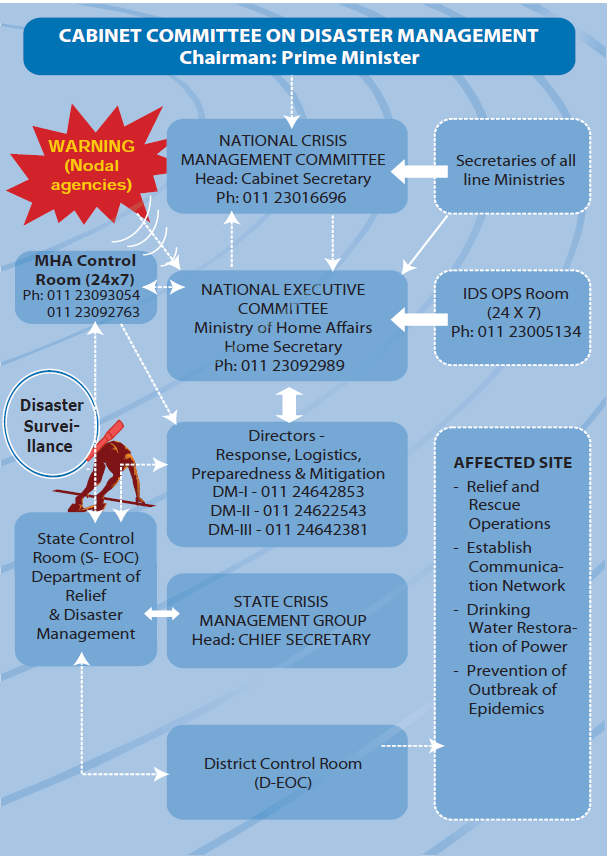
National Disaster Management Authority
- The National Disaster Management Authority (NDMA) under the Chairmanship of the Prime Minister is the apex body responsible for laying down policies, plans and guidelines for disaster management and for coordinating their enforcement and implementation throughout the country.
- The policies and guidelines will assist the Central Ministries, State Governments and district administration to formulate their respective plans and programmes.
- NDMA has the power to approve the National Plans and the Plans of the respective Ministries and Departments of Government of India. The general superintendence, direction and control of National Disaster Response Force (NDRF) are vested in and will be exercised by the NDMA.
Prime Minister’s 10 Point Agenda on Disaster Risk Reduction
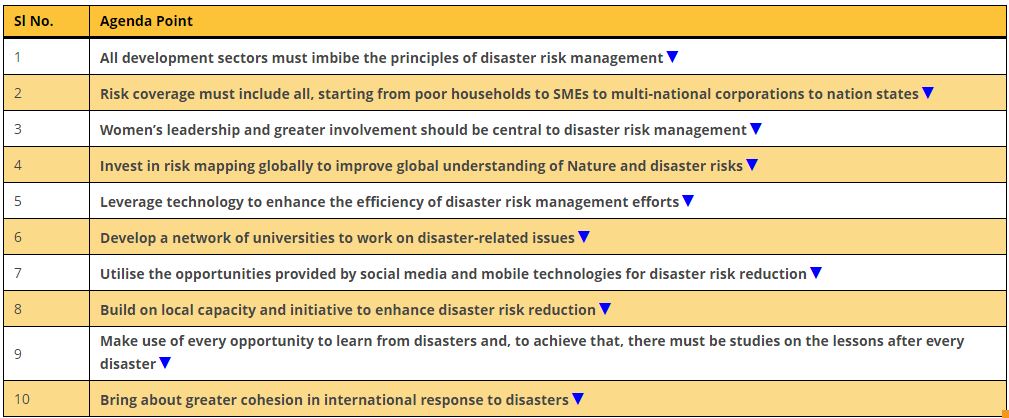
https://www.pib.gov.in/PressReleasePage.aspx?PRID=1839896









